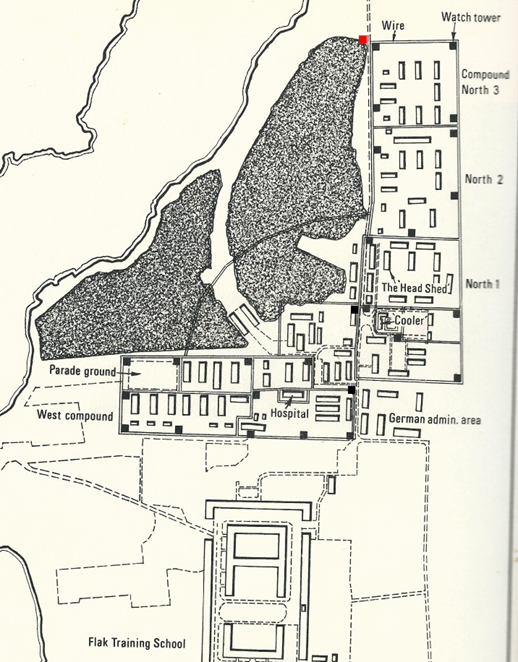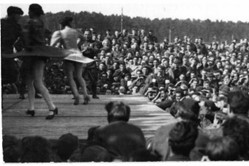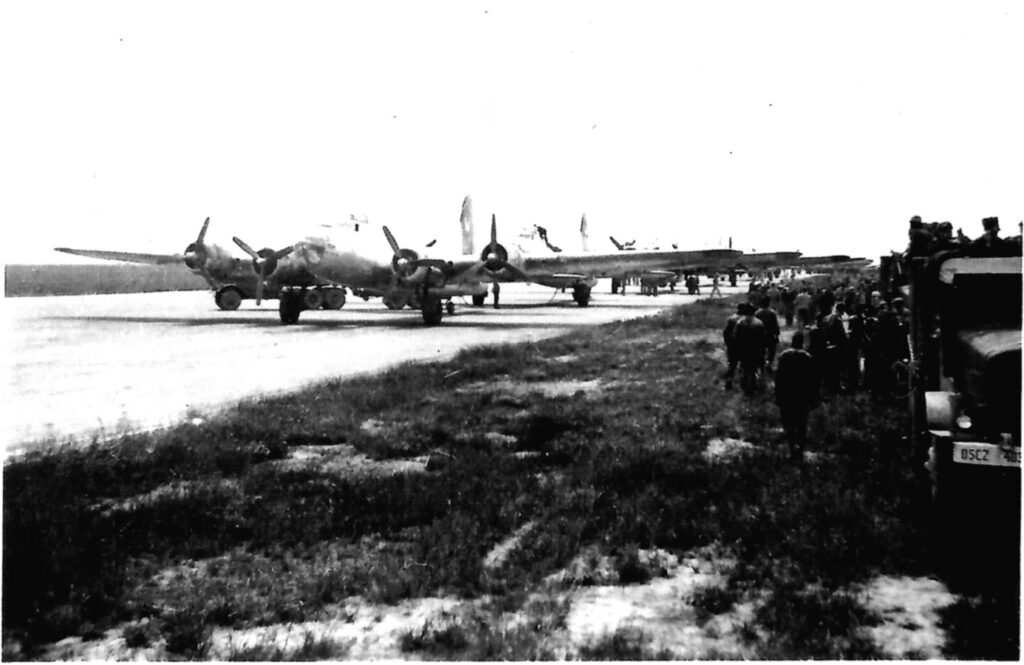
The last days of Stalag Luft I
The German guards of Stalag Luft I fled from the approaching Red Army on the night of 30 April to 1 May 1945. Originally, they wanted to force the prisoners of war to leave the camp with them. But even under threat of armed force, Senior Allied Officer Colonel Zemke (USAAF) refused this order and so the prisoners of war virtually liberated themselves.
At 10 a.m. on 2 May 1945, the 133rd Soviet Guards Regiment took Barth without a fight. Colonel Hubert Zemke and his deputy, Group Captain Cecil Weir (RCAF), were present at the handover of the town of Barth to the Red Army.
Meanwhile, many camp inmates left the camp and strolled through the surrounding area. Some discovered Barth Concentration Camp at the airfield and were horrified to see hundreds of half-starved people and dozens of dead prisoners lying around in the completely filthy and lice-infested rooms. British and American medical doctors together with volunteers did their best to care for the sick and brought them to the military hospital at the airbase and to the hospital at Stalag Luft I.

Photo by Roy Kilminster source: http://www.merkki.com/russians.htm
In the meantime thousands of young men had been waiting impatiently for their return home since 30 April, but the Soviet side took its time. By order of the Soviet Marshal Rokossowski the Soviet troops at Barth supplied their allies and took care of their physical well-being. They drove dozens of live cattles and pigs into the camp to be slaughtered. Cultural events such as the performance of a Soviet dance ensemble united the men on both sides.
In these days, the western Allies troups were near Schwerin and did not advance any further. The Red Army controlled the entire eastern Mecklenburg region, and as a matter of fact also Stalag Luft I. They initially wanted to transport the inmates by land to Odessa, from where they were to continue their journey by ship. The Black Sea port was the traditional exchange point for Soviet prisoners of war with their Western Allied comrades.
The American and British high staffs, on the other hand, preferred an immediate air evacuation by the Air Force. The conditions in Barth were excellent for this. A fully operational airbase with a suitably developed runway offered the best conditions.
Meanwhile Colonel Zemke and Group Captain Weir, endeavored to establish a good relationship with the Soviet officers on site. Relations were friendly and relaxed. Zemke placed the camp – without restrictions – under Soviet command. The prisoners of war were given passes to walk into the town. However, the Russian patrols were allowed to use their weapons in case of misbehavior.
Colonel Zemke had initially obtained permission from the Soviet command to demine the airport. On 5 May 1945, the Red Army suddenly stopped the demining work. Zemke wrote directly to Marshal Rokossowski and asked for an air corridor to be set up. However, he received no reply.
The repatriation was delayed more and more, to the great displeasure of the impatient inmates, who were still in the camp. Although the Western Allies did not want long negotiations with the Red Army, there seemed to be no way out, and a political solution had to be found.
However, the Soviets were not interested in a quick solution. After all, in military terms, it was a matter of repatriating 9,000 Allied airmen with combat experience in strategic air warfare, which the Red Air Fleet did not have. With the officers and men who were still behind barbed wire in Barth, the Americans could easily have assembled another powerful air force. The number of airmen incarcerated was far higher than the number of those who had flown their attacks against Nazi Germany in the flying units of the mighty 8th Air Force in April 1945.
On 7 May 1945, British Field Marshal Montgomery met with Marshal Rokossowski in a tense atmosphere in Wismar. Montgomery vehemently advocated the immediate repatriation of the Barth prisoners. However, Rokossowski only gave the order to continue supplying the camp. Everything could still lead to the prisoners being transported back via Odessa.
Another reason for the hesitant attitude of the Soviets was that the hated General Wlassow, who had defected to the Germans, had surrendered to the Americans near Pilsen and there was nothing indicating that he was to be handed over to the Red Army. The former Red Army general had raised troops from Soviet prisoners of war to fight on the German side.
On 8 May 1945, the unconditional German surrender was signed in Berlin – Karlshorst in the presence of Marshal Shukow.
On 12 May 1945 General Wlassow and his soldiers were handed over to the Soviet authorities. The Soviet delaying tactics were thus successful, but in return, Stalag Luft I was finally allowed to be evacuated by the Western Allies. On 13 May 1945, at around 2 p.m., American “flying fortresses” of the 8th US Air Fleet were again heard over Barth, which began evacuating the occupants immediately after landing.
The operation lasted until 15 May 1945. Colonel Zemke was the last of the approximately 9,000 to board the last plane to leave Barth.
This precisely prepared “airlift” went down in military history as “Operation Revival”.
